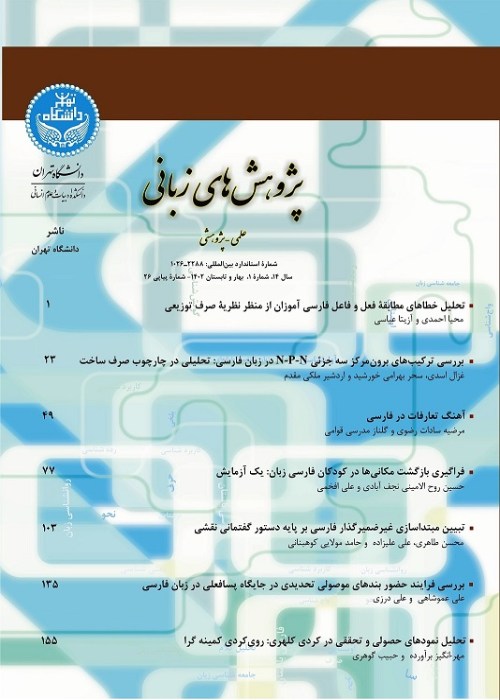Electrophysiological Evidence of Neurological Representations of the Phonological and Phonetic Properties of Persian Vowels in the Auditory Cortex
Author(s):
Article Type:
Research/Original Article (دارای رتبه معتبر)
Abstract:
How the brain encodes the speech acoustic signal into phonological representations is a fundamental question for the neurobiology of language. The following paper is aimed to investigate the relationship between the phonological and phonetic properties of Persian simple vowels and neurophysiological events corresponding to them. To achieve such goal, we employed electroencephalography to map the Persian vowel system onto cortical sources using the N1 auditory evoked component. We found evidence that the N1 is characterized by asymmetrical indexes in the auditory areas of the cortex, structuring vowel representations. Properties of these ERPs were analyzed and modelled on one hand by the landmarks in the spectral window of their respective stimulus (such as F1, F2 and F2-F1) and on the other hand by the phonological distinctive features categorizing them (namely, height and place). The results revealed that the responses contain at least two distinguishable modulations of N1 components: a symmetric N1a which peaked between 113 to 149 milliseconds after the onset of the stimulus and a heavily left-leaning N1b which peaked between 149 to 170 milliseconds thereafter. Both N1a and N1b subcomponents showed strong correlations with a variety of parameters of both phonological and acoustic nature of the respective stimuli. However, N1a was significantly better modelled by acoustic factors while N1b displayed a better fit to a model based on phonetic factors. Based on such results, this paper argues that firstly the perceptual procedure of vowel categorization is a gradient process starting from demarcation of the stimulus signal according to acoustic landmarks which is done almost symmetrically then the processing load shifts significantly to the left hemisphere for the categorization of the input based on its perceived distinctive features. And secondly, that such information can be exploited to draft a ‘tonochronic’ map of such perceptual processes and define a perceptual field for every vowel and distinctive feature in the tonochronic space.
Keywords:
Language:
Persian
Published:
Language Research, Volume:11 Issue: 2, 2021
Pages:
223 to 245
magiran.com/p2260080
دانلود و مطالعه متن این مقاله با یکی از روشهای زیر امکان پذیر است:
اشتراک شخصی
با عضویت و پرداخت آنلاین حق اشتراک یکساله به مبلغ 1,390,000ريال میتوانید 70 عنوان مطلب دانلود کنید!
اشتراک سازمانی
به کتابخانه دانشگاه یا محل کار خود پیشنهاد کنید تا اشتراک سازمانی این پایگاه را برای دسترسی نامحدود همه کاربران به متن مطالب تهیه نمایند!
توجه!
- حق عضویت دریافتی صرف حمایت از نشریات عضو و نگهداری، تکمیل و توسعه مگیران میشود.
- پرداخت حق اشتراک و دانلود مقالات اجازه بازنشر آن در سایر رسانههای چاپی و دیجیتال را به کاربر نمیدهد.
In order to view content subscription is required
Personal subscription
Subscribe magiran.com for 70 € euros via PayPal and download 70 articles during a year.
Organization subscription
Please contact us to subscribe your university or library for unlimited access!


